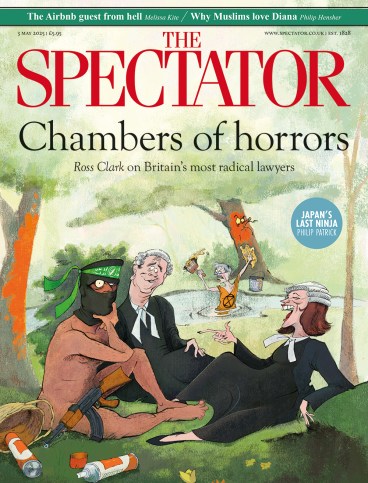
‘Tawny owls,’ I tell friends and family, ‘can’t see in the dark any better than we can. So they memorise the whole wood! But they may be able to see sound,’ I burble. ‘And the Latin name for a blue tit is Cyanistes caeruleus obscurus: Heavenly hidden blue one!’
In Bird School, Adam Nicolson rejoices in the detailed stories of some of the birds on his farm in Sussex. Its precursor, The Seabird’s Cry, a love letter to a dozen species, soared over the coasts of Scotland, ablaze with sea light. The Sussex Weald on a dull spring dawn offers a claggier setting. Puffins seem more interesting than marsh tits.
But in fact Bird School is even better. Nicolson makes like the bowerbird, which constructs elaborate artistic temples of seduction. Most of us, if we’d resolved to study local birds, would erect feeders and bird-boxes. Nicolson commissions an ‘absorbatory’ – a shed on stilts with nest boxes in the walls. He sets up his desk and brings birds, and an infinite world, to him. ‘On moonlit dawns, each of the raindrops hanging from the tips of the birches and hazels held a bright white moon inside it like a fly in amber.’
Later in the year, in summer, he notices fledgling wrens emerging from their nest:
The little birds, as round as bumble bees, were dropping like drips from a tap out of the mossy cushion their parents had pushed into the gap in the brickwork. One after another they came, each one a gobbet of life.
This is some of the best English prose of our time. Trees respond to a storm like ‘horses on a halter’. Nicolson’s work is engrossing and uplifting because his extraordinary descriptive powers are matched by his attention and insight. He takes us into the ‘dull tawny orange’ of a singing dunnock’s mouth, but he is never po-faced, quoting Ted Hughes on the crow: ‘A bookload of such descriptions is immediately rubbish when you look up and see the crow flying.’ His company is such fun and his information so absorbing that you forget that this is also a song of outraged resistance. Catastrophes of environmental degradation are driven by indifference, Nicolson says – ‘indifference that led me finally to build a birdhouse and to write this book – the landscape of a general carelessness and ignorance’.
Bird School demands that we expand our bordered selves and our limited knowledge, that we inhabit wider realities made of other lives. Birdhouse and book are designed to enable ‘permeation, the flooding in and through of all things by all things… the core ecological idea’.
And so, species by species, we learn about competition, territory, migration, song, sex and natural selection. Readers will live henceforth in a map of Eurasia divided into a jigsaw of robin territories, created and maintained in notes:
A bird’s territory is not an object but a composition, an amalgam of bird, place, time and song. Birdsong actually enters you and reverberates within your skull, so that your own body also becomes part of the bird’s song-body world.
A chapter on ravens explains that we domesticated dogs around 13,000 BC, but we were living with and eating ravens in 28,000 BC. Their ‘quork-talk’ is speech from the Ice Age and also – thanks to similarities in the throats of ravens and the dinosaurs from which all birds descend – ‘the sound of the Jurassic and the Cretaceous, a pre-mammalian voice’.
Ravens read each other’s minds and soothe one another by squeezing a wing-tip with their bill. Blackbirds craft their songs through an aesthetic editorial process. Birds’ songs are far more complex than we can hear (their syrinx is a double voice-box, our hearing relatively slow and narrow), but thanks to the Merlin bird app – to which Nicolson is devoted, and you will be, too – we can identify them as never before.
Bird School relishes the tricks with which life meets the Darwinian imperative, but this goes beyond the survival of genes. What else is survival for? Semi-deafened by our own strident battles for territories of fragmenting attention, our society’s increasing despair and declining mental health are not mysteries.
It is vital to our senses of hope and meaning that we attend to what is present in the world and what composes this present, Nicolson argues. He watches small birds feeding:
It is strange how much happiness it brings. I can hardly tear myself away. I am learning nothing. The birds are acting out the drama of continuousness, the theatre of things happening. In the grip of it, nothing matters more: not how things are, but that they are.
The genius of this book is to marry the study of both, in art and joyful craft.





Comments